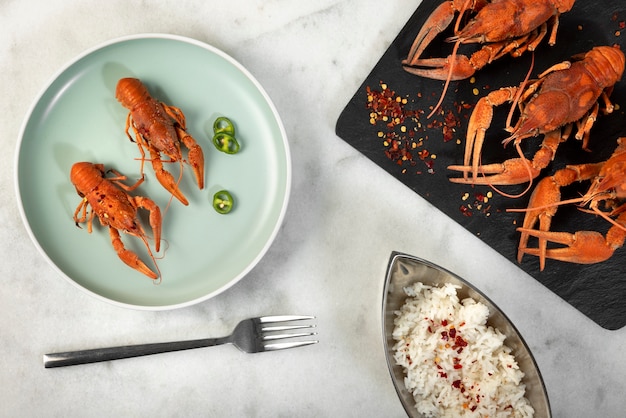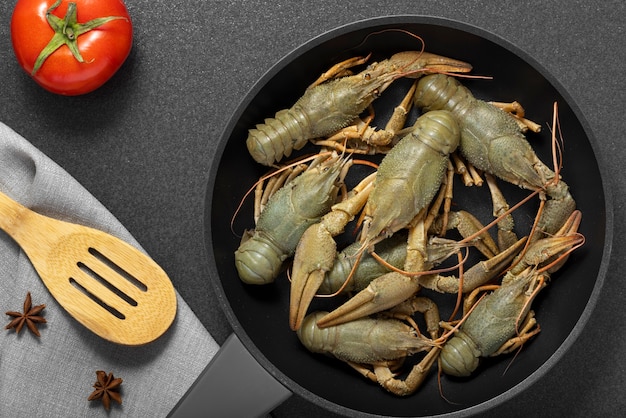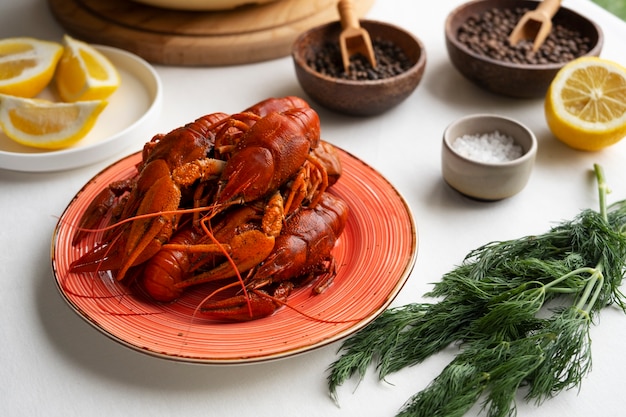The aroma of freshly steamed crab, that intoxicating blend of salt, brine, and a hint of sweetness, is enough to make anyone's mouth water. But achieving that perfect, succulent, and flavorful crab meat requires more than just tossing it into a steamer and hoping for the best. There's a bit of an art and science to it, and believe me, I've learned the hard way. Remember that time I overcooked a crab and it ended up like rubber? Not a good look. So, let's embark on a journey together, exploring the world of steamed crab and unlocking the secrets to achieving perfect results every time.
(Part 1) choosing the right crab: It All Starts with a Good Foundation

Just like any culinary masterpiece, a delectable steamed crab starts with choosing the right ingredients. When it comes to crabs, freshness and quality are paramount. If you're lucky enough to have access to a local fishmonger, strike up a conversation with them. Ask about the crab's origin, how long it's been caught, and how it's been stored. You'd be surprised at how much a bit of good quality control can make a difference.
Size also matters. Smaller crabs, typically weighing around 1-2 pounds, will cook quicker than their larger counterparts, which can weigh up to 5 pounds or more. And then there's the type of crab. A plump Dungeness crab, known for its sweet, delicate flavor, will have a different steaming time than a meaty Blue Crab, prized for its savory, slightly briny taste.
The Art of Choosing a Good Crab
Here are a few tips to help you choose the freshest and most flavorful crab:
- Lively and Alert: A good crab should be full of life, actively moving its legs and claws. If it's sluggish or unresponsive, it's probably not the freshest.
- Vibrant Shell Color: A fresh crab will have a vibrant shell color, free from any dullness or fading. A healthy crab will also have a moist, shiny shell.
- Heaviness for its Size: A crab that feels heavy for its size is a sign that it's full of juicy meat. Give it a gentle lift to assess its weight.
- Clean and Salty Aroma: A fresh crab should have a clean, slightly salty smell. Avoid crabs with any unpleasant or fishy odors.
(Part 2) Preparing the Crab: A Ritual for Flavor

You've got your crab, now it's time to get down to business. The preparation process, while seemingly simple, is an integral part of unlocking the best flavor from that delicious crab meat. It's all about a little finesse and care, especially when dealing with larger crabs.
Cleaning the Crab: A Quick Rinse for Freshness
First, give your crab a quick rinse under cold water. This is to remove any dirt, debris, or anything else that might be clinging to its shell. If you're dealing with a live crab, you might want to pop it in the freezer for a few minutes to stun it before cleaning. This is a humane way to reduce any distress. I remember seeing a seafood market in France where they used a special tool to break the crab's legs before steaming. That was a bit too much for me. I prefer to think I'm a bit more humane, I guess that's just my British way.
Tying Up the Crab: Keeping it in Shape
Next, we need to tie up our crab. This helps to keep it in shape during the steaming process, preventing it from falling apart, which is a bit of a culinary disaster. You can use string or kitchen twine to tie the legs together, and secure the claws with a rubber band or by folding them over the body. Be careful with the claws, they can be quite strong! You don't want to get pinched. Been there, done that. You can also use a dedicated crab steamer pot that has a built-in mechanism for holding the crab securely.
(Part 3) The Steam Room: A Symphony of Heat and Flavor

Now we're ready for the main event, the steaming process. You've chosen your crab, cleaned it, and tied it up. The steaming process is where the magic really happens. I've tried various methods over the years, from fancy bamboo steamers to trusty old saucepans with colanders. It's all about finding what works best for you.
Choosing the Right Steamer: A Matter of Preference
There are a few different types of steamers you can use for your crab, each with its own advantages:
- Bamboo steamer: This is the traditional method, offering a beautiful, authentic flavor. Just make sure it's large enough to fit your crab comfortably. There's something about using a bamboo steamer that adds a touch of elegance to the process.
- Stainless steel steamer: This is a modern, practical option that's easy to clean and incredibly durable. There's a wide range of sizes available, so you can find one that fits your needs perfectly. A classic and reliable choice.
- Steamer pot: A steamer pot has a built-in steamer basket, so you don't need to worry about finding a separate steamer. This is a great option for steaming fish and vegetables, too. It's a versatile addition to any kitchen.
Getting the Steam Up: The Essence of Even Cooking
Whether you're using a bamboo steamer or a stainless steel steamer, the principle is the same. You need to make sure the water in the base of the steamer is boiling before you add your crab. You don't want to steam your crab in lukewarm water, it'll just end up a soggy mess. Once the water is boiling, add your crab to the steamer and cover it with the lid. Make sure the lid is snug so the steam can't escape. The time it takes to steam the crab will depend on its size and type, so refer to the steaming times chart below for guidance.
(Part 4) Steaming Times: Timing is Everything
This is where the science of steaming crabs comes in. You want to get the timing right, no overcooking, no undercooking. It's a delicate balance! The steaming time will depend on the size and type of crab you have. As a general rule, smaller crabs will cook quicker than larger ones. A small crab might only need 10-15 minutes, while a larger crab could take 20-25 minutes.
Steaming Times Chart: Your Guide to Perfect Crab
| Type of Crab | Size (lbs) | Steaming Time (minutes) |
|---|---|---|
| Dungeness Crab | 1-2 lbs | 15-20 |
| Dungeness Crab | 2-3 lbs | 20-25 |
| Blue Crab | 1-2 lbs | 10-15 |
| Blue Crab | 2-3 lbs | 15-20 |
| King Crab | 3-4 lbs | 25-30 |
| King Crab | 4-5 lbs | 30-35 |
(Part 5) Checking for Doneness: Signs of a Perfectly Steamed Crab
You've got your crab steaming away, but how do you know when it's ready? You can't just open the lid and peek in. That's a big no-no, it disrupts the steam and can lead to uneven cooking. You need to be clever about it. There are a couple of reliable tricks for determining when your crab is cooked through.
The Shell Test: A Gentle Twist for Confirmation
This is one of the most reliable methods to check for doneness. Gently lift one of the crab's legs and twist it. If the leg comes off easily, it's cooked through. If it feels stuck, it needs a few more minutes. Don't worry, it's not as brutal as it sounds. You just need a light twist. You can also check the color of the crab. A cooked crab will have a slightly redder color than a raw crab.
The Meat Test: A Peek Inside for Assurance
If you're still unsure, you can try the meat test. Carefully insert a thin-bladed knife into the thickest part of the leg. If the meat is firm and opaque, it's cooked. If it's still translucent, it needs more time. You can also look for a slight pink hue in the meat, this is a good sign it's cooked through.
(Part 6) Serving Up the Steamed Crab: A Feast for the Senses
Alright, your crab is cooked to perfection, now it's time to enjoy the fruits of your labor. But don't just go diving in with your bare hands, there's a bit of finesse to it. It's about presentation, you know, making that special occasion even more special.
Cracking Open the Crab: Unlocking the Delicacies Inside
The fun part, cracking open the crab! You can use a crab cracker or a heavy knife. If you're using a cracker, be careful not to crush the crab too much, you don't want to lose all the delicious meat. If you're using a knife, aim for the joints and twist to break them apart. Once you've cracked open the shell, you can use a fork or a small spoon to pick out the meat.
Garnishes and Dipping Sauces: Elevating the Flavor
You've got your juicy crab meat, now it's time to get creative with your garnishes and sauces. Some classic options include melted butter, lemon wedges, and hot sauce. But you can also get adventurous with your sauces. For example, aioli, garlic butter, or even a spicy sriracha mayo. You can also add a few fresh herbs, like parsley or chives, for a pop of flavor.
(Part 7) Storage and Leftovers: Keeping the Goodness Alive
You've enjoyed your delicious steamed crab, but what about the leftovers? You've got to be smart about storing it, you don't want it to go to waste. It's all about preserving that freshness and flavor.
Storage Tips: Preserving the Deliciousness
If you have leftover crab, it's best to store it in an airtight container in the refrigerator for up to 3-4 days. You can also freeze crab for up to 3 months. But the best way to freeze it is to remove the meat from the shell and place it in a freezer-safe bag or container. This helps to maintain its texture and flavor.
Reheating Leftovers: A Gentle Approach to Recapture Flavor
If you're reheating leftover crab, it's best to do it gently. You can reheat it in a microwave on low power or in a preheated oven at a low temperature. You can also add a splash of water or broth to help keep the meat moist. Avoid reheating crab on high heat as this can dry out the meat and make it tough. Remember, it's all about keeping that delicate flavor.
(Part 8) FAQs: Addressing Your Steaming Crab Concerns
Let's clear up some common questions about steaming crabs, just so we're all on the same page.
1. Can you steam crabs with other ingredients?
Absolutely! Steaming crabs with other ingredients like vegetables, herbs, or spices can add extra layers of flavor. Some popular options include: corn on the cob, potatoes, onions, garlic, ginger, and lemongrass. Just make sure the other ingredients are cut into small pieces so they cook evenly. It's all about creating a beautiful, aromatic symphony of flavors.
2. How can I tell if a crab is still alive?
If you're buying a live crab, there are a few ways to tell if it's still alive. The crab should be active and moving its legs and claws. It should also have a moist, shiny shell. You can also try gently tapping the crab's shell. If it's alive, it will react and move away from the tap. Always handle live crabs with caution, they can pinch. It's best to ask a fishmonger for help if you're unsure.
3. What if I overcook my crab?
If you overcook your crab, the meat will become tough and rubbery. It will also have a less desirable flavor. If you're unsure about the cooking time, it's better to err on the side of caution and undercook it slightly. You can always cook it a little longer if it's not quite done. It's better to have a slightly undercooked crab than an overcooked one.
4. What are some good dipping sauces for steamed crab?
There are many delicious dipping sauces for steamed crab. Some classic options include melted butter, lemon wedges, and hot sauce. But you can also get adventurous with your sauces. For example, aioli, garlic butter, or even a spicy sriracha mayo. You can also add a few fresh herbs, like parsley or chives, for a pop of flavor. The possibilities are endless, so experiment and find what you like best.
5. Is it safe to eat raw crab?
It's generally not recommended to eat raw crab. Crab meat can contain harmful bacteria that can cause food poisoning. It's always best to cook crab thoroughly to kill any bacteria. Always err on the side of caution when it comes to seafood safety.
Everyone is watching

Corn on the Cob: The Ultimate Guide to Perfectly Cooked Ears
Healthy MealsAh, corn on the cob. Just the name evokes images of sunny days, barbecues, and that sweet, juicy flavour that ...

Perfect Pork Roast Oven Cooking Time: A Guide to Delicious Results
Healthy MealsThere's something truly satisfying about a perfectly roasted pork. The aroma alone is enough to make your mout...

Ham Cooking Time: How Long to Bake, Smoke, or Boil a Delicious Ham
Healthy MealsAh, ham. It's a classic, isn't it? A real crowd-pleaser, especially around holidays. And when done right, it'...

Scallops: The Ultimate Guide to Perfect Cooking
Healthy MealsAh, scallops. Those delicate, sweet, and utterly delicious morsels of the sea. They hold a special place in my...

Spaghetti Squash: The Ultimate Guide to Cooking and Serving
Healthy MealsRemember that time you saw spaghetti squash at the supermarket, looking all bumpy and strange, and thought, "W...
